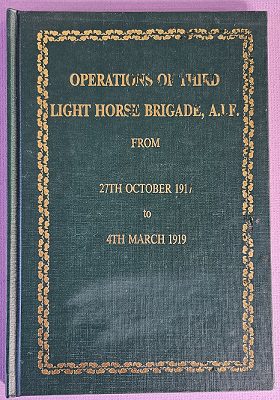Description
Title: With the Ninth Light Horse in the Great War
Author: Darley, Thomas Henry
Condition: Mint
Edition: 5th Edition
Publication Date: 2015
ISBN: 9781845747718
Cover: Hard Cover without Dust Jacket – 244 pages
Comments: The detailed history of the 9th Light Horse Regiment AIF – Limited edition of 45.
The 9th Light Horse Regiment was formed in Adelaide and trained in Melbourne between October 1914 and February 1915. Approximately three-quarters of the regiment hailed from South Australia and the other quarter from Victoria. As part of the 3rd Light Horse Brigade, it sailed from Melbourne on 11 February and arrived in Egypt on 14 March 1915.
The light horse were considered unsuitable for the initial operations at Gallipoli, but were subsequently deployed without their horses. The 3rd Light Horse Brigade landed in late May 1915 and was attached to the New Zealand and Australian Division. The 9th was fortunate to be the reserve regiment for the Brigade’s disastrous attack on the Nek on 7 August, but subsequently suffered 50 per cent casualties attacking Hill 60 on 27 August. Exhausted and under-strength, the 9th then played a defensive role until it finally left the peninsula on 20 December 1915.
Back in Egypt, the 3rd Light Horse Brigade became part of the ANZAC Mounted Division and, in March 1916, joined the forces defending the Suez Canal from a Turkish drive across the Sinai Desert. The Turks were turned at Romani. Although it didn’t take part in the actual battle, the 9th Light Horse was involved in the advance that followed the Turks’ retreat back across the desert.
By December 1916, this advance had reached the Palestine frontier and the 9th was involved in the fighting to secure the Turkish outposts of Maghdaba (23 December) and Rafa (9 January 1917), both of which were captured at bayonet point. The next Turkish stronghold to be encountered was Gaza. The 3rd Light Horse Brigade, now part of the Imperial Mounted Division (later re-named the Australian Mounted Division), was involved in the two abortive battles to capture Gaza directly (27 March and 19 April 1917) and then the operation that ultimately led to its fall – the wide outflanking move via Beersheba that began on 31 October.
With the fall of Gaza on 7 November 1917, the Turkish position in southern Palestine collapsed. The 9th participated in the pursuit that followed and led to the capture of Jerusalem in December. The focus of British operations then moved to the Jordan Valley. In early May 1918 the 9th was involved in the Es Salt raid. It was a tactical failure but did help to convince the Turks that the next offensive would be launched across the Jordan.
Instead, the offensive was launched along the coast on 19 September 1918. The mounted forces penetrated deep into the Turkish rear areas severing roads, railways and communications links. The 9th Light Horse took part in the capture of Jenin on 20–21 September and Sasa on 29 September. It entered Damascus on 1 October, and was on the road to Homs when the Turks surrendered on 31 October. While awaiting to embark for home, the 9th Light Horse were called back to operational duty to quell the Egyptian revolt that erupted in March 1919; order was restored in little over a month. The regiment sailed for home on 10 July 1919.
Includes Roll of Honour and Nominal Roll by the reinforcements and the embarkation dates.




